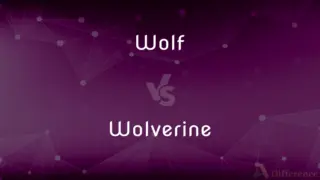Flower vs. Bud — What's the Difference?
Edited by Tayyaba Rehman — By Urooj Arif — Updated on March 14, 2024
A flower is a mature reproductive structure in plants, showcasing petals and reproductive organs, while a bud is an undeveloped or early stage of a flower or leaf.

Difference Between Flower and Bud
Table of Contents
ADVERTISEMENT
Key Differences
A flower represents the reproductive phase in the life cycle of many plants, characterized by its colorful petals and organs for reproduction. On the other hand, a bud is an immature precursor to such structures, containing undeveloped tissue that will eventually grow into a flower or leaf.
Flowers are often associated with the process of pollination and the production of seeds, which are essential for the continuation of plant species. Whereas, buds are involved in the growth and development phase, signaling the potential for new leaves, flowers, or shoots.
While flowers can vary widely in color, size, shape, and fragrance, designed to attract pollinators, buds are generally more uniform in appearance, with variations mostly in size and shape depending on the species.
Flowers serve as the primary site for reproduction in plants, featuring stamens and pistils that facilitate the production of seeds. In contrast, buds do not participate directly in reproduction but are crucial for the plant's growth and eventual reproductive capability.
The presence of flowers often indicates a plant's readiness to reproduce and can be a sign of the plant's health and maturity. Conversely, buds signify the early stages of growth and the potential for future blossoming and reproduction.
ADVERTISEMENT
Comparison Chart
Definition
A mature reproductive structure of a plant.
An undeveloped or early stage of a flower or leaf.
Role
Reproduction, attraction of pollinators.
Growth, potential for future development.
Appearance
Varied colors, sizes, and shapes.
Generally uniform, with variations in size and shape.
Function
Reproduction, seed production.
Growth and development of plant parts.
Indicator of
Plant's reproductive readiness and health.
Early growth stage and potential for development.
Compare with Definitions
Flower
The colorful and fragrant part of a plant used for reproduction.
The garden was full of blooming flowers in spring.
Bud
A compact knob-like growth on a plant that develops into a leaf, flower, or shoot.
The rose bushes are full of buds ready to open.
Flower
The culmination or peak phase in a plant’s life cycle.
The apple tree's flowers are a sign it's ready to produce fruit.
Bud
A protective structure that houses a developing flower or leaf.
Each bud is carefully protected by layers until it's ready to bloom.
Flower
A decorative or symbolic representation of beauty in plants.
She wore a dress adorned with flower patterns for the spring festival.
Bud
The initial phase of a plant's or branch's development.
Pruning the buds helps shape the growth of the plant.
Flower
The seed-bearing part of a plant, consisting of reproductive organs.
Each flower in the field had begun to produce seeds.
Bud
The early stage of a flower or leaf before it unfolds.
You can see the bud beginning to split and a new flower emerging.
Flower
A mature and pollination-ready part of a plant.
The bee buzzed from flower to flower collecting nectar.
Bud
A sign of new growth and potential on plants.
The appearance of buds on trees is a herald of spring.
Flower
A flower, sometimes known as a bloom or blossom, is the reproductive structure found in flowering plants (plants of the division Magnoliophyta, also called angiosperms). The biological function of a flower is to facilitate reproduction, usually by providing a mechanism for the union of sperm with eggs.
Bud
In botany, a bud is an undeveloped or embryonic shoot and normally occurs in the axil of a leaf or at the tip of a stem. Once formed, a bud may remain for some time in a dormant condition, or it may form a shoot immediately.
Flower
The reproductive structure of angiosperms, characteristically having either specialized male or female organs or both male and female organs, such as stamens and a pistil, enclosed in an outer envelope of petals and sepals.
Bud
A small protuberance on a stem or branch, sometimes enclosed in protective scales and containing an undeveloped leaf, flower, or leafy shoot.
Flower
Such a structure having showy or colorful parts; a blossom.
Bud
The stage or condition of having buds
Branches in full bud.
Flower
A flower head.
Bud
Flowers from a female cannabis plant, especially after being harvested and prepared for smoking or other use
Bought some bud.
Flower
A plant that is cultivated or appreciated for its blossoms.
Bud
A single flower of a cannabis plant, especially a female flower
When to harvest buds.
Flower
The condition or a time of having developed flowers
The azaleas were in full flower.
Bud
A small, rounded organic part, such as a taste bud, that resembles a plant bud.
Flower
The period of highest development or greatest vigor. ]
Bud
One that is not yet fully developed
The bud of a new idea.
Flower
(botany) A reproductive structure in angiosperms (flowering plants), often conspicuously colourful and typically including sepals, petals, and either or both stamens and/or a pistil.
Bud
An earbud.
Flower
A plant that bears flowers, especially a plant that is small and lacks wood.
We transplanted the flowers to a larger pot.
Bud
Friend; chum. Used as a form of familiar address, especially for a man or boy
Move along, bud.
Flower
A cut flower; the stem of a flowering plant with the blossom or blossoms attached, used for decoration, as a gift, etc.
He always keeps a vase full of flowers in his office.
Bud
To put forth or produce buds
A plant that buds in early spring.
Flower
(usually with in) Of plants, a state of bearing blooms.
The dogwoods are in flower this week.
Bud
To develop or grow from or as if from a bud
"listened sympathetically for a moment, a bemused smile budding forth" (Washington Post).
Flower
The vulva, especially the labia majora.
Bud
To be in an undeveloped stage or condition.
Flower
The best examples or representatives of a group.
Bud
To cause to put forth buds.
Flower
The best state of things; the prime.
She was in the flower of her life.
Bud
To graft a bud onto (a plant).
Flower
(obsolete) Flour.
Bud
A newly sprouted leaf or blossom that has not yet unfolded.
After a long, cold winter, the trees finally began to produce buds.
Flower
A substance in the form of a powder, especially when condensed from sublimation.
The flowers of sulphur
Bud
(figuratively) Something that has begun to develop.
Breast buds
Flower
A figure of speech; an ornament of style.
Bud
A small rounded body in the process of splitting from an organism, which may grow into a genetically identical new organism.
In this slide, you can see a yeast cell forming buds.
Flower
(printing) Ornamental type used chiefly for borders around pages, cards, etc.
Bud
Potent cannabis taken from the flowering part of the plant (the "bud"), or marijuana generally.
Hey bro, want to smoke some bud?
Flower
Menstrual discharges.
Bud
A weaned calf in its first year, so called because the horns are then beginning to bud.
Flower
A delicate, fragile, or oversensitive person.
Bud
A pretty young girl.
Flower
(rare) Something that flows, such as a river.
Bud
Buddy, friend.
I like to hang out with my buds on Saturday night.
Flower
To put forth blooms.
This plant flowers in June.
Bud
Used to address a male
Flower
To decorate with pictures of flowers.
Bud
(intransitive) To form buds.
The trees are finally starting to bud.
Flower
To reach a state of full development or achievement.
Bud
(intransitive) To reproduce by splitting off buds.
Yeast reproduces by budding.
Flower
To froth; to ferment gently, as new beer.
Bud
(intransitive) To begin to grow, or to issue from a stock in the manner of a bud, as a horn.
Flower
To come off as flowers by sublimation.
Bud
(intransitive) To be like a bud in respect to youth and freshness, or growth and promise.
Flower
In the popular sense, the bloom or blossom of a plant; the showy portion, usually of a different color, shape, and texture from the foliage.
Bud
(transitive) To put forth as a bud.
Flower
The fairest, freshest, and choicest part of anything; as, the flower of an army, or of a family; the state or time of freshness and bloom; as, the flower of life, that is, youth.
The choice and flower of all things profitable the Psalms do more briefly contain.
The flower of the chivalry of all Spain.
A simple maiden in her flowerIs worth a hundred coats of arms.
Bud
(transitive) To graft by inserting a bud under the bark of another tree.
Flower
Grain pulverized; meal; flour.
The flowers of grains, mixed with water, will make a sort of glue.
Bud
A small protuberance on the stem or branches of a plant, containing the rudiments of future leaves, flowers, or stems; an undeveloped branch or flower.
Flower
A substance in the form of a powder, especially when condensed from sublimation; as, the flowers of sulphur.
Bud
A small protuberance on certain low forms of animals and vegetables which develops into a new organism, either free or attached. See Hydra.
Flower
A figure of speech; an ornament of style.
Bud
To put forth or produce buds, as a plant; to grow, as a bud does, into a flower or shoot.
Flower
Ornamental type used chiefly for borders around pages, cards, etc.
Bud
To begin to grow, or to issue from a stock in the manner of a bud, as a horn.
Flower
Menstrual discharges.
Bud
To be like a bud in respect to youth and freshness, or growth and promise; as, a budding virgin.
Flower
To blossom; to bloom; to expand the petals, as a plant; to produce flowers; as, this plant flowers in June.
Bud
To graft, as a plant with another or into another, by inserting a bud from the one into an opening in the bark of the other, in order to raise, upon the budded stock, fruit different from that which it would naturally bear.
The apricot and the nectarine may be, and usually are, budded upon the peach; the plum and the peach are budded on each other.
Flower
To come into the finest or fairest condition.
Their lusty and flowering age.
When flowered my youthful spring.
Bud
A partially opened flower
Flower
To froth; to ferment gently, as new beer.
That beer did flower a little.
Bud
A swelling on a plant stem consisting of overlapping immature leaves or petals
Flower
To come off as flowers by sublimation.
Observations which have flowered off.
Bud
Develop buds;
The hibiscus is budding!
Flower
To embellish with flowers; to adorn with imitated flowers; as, flowered silk.
Bud
Start to grow or develop;
A budding friendship
Flower
A plant cultivated for its blooms or blossoms
Flower
Reproductive organ of angiosperm plants especially one having showy or colorful parts
Flower
The period of greatest prosperity or productivity
Flower
Produce or yield flowers;
The cherry tree bloomed
Common Curiosities
What is a flower?
A flower is the reproductive structure of a plant, known for its colorful petals and capacity for producing seeds.
What is a bud?
A bud is a young, undeveloped part of a plant that will grow into a new leaf, flower, or shoot.
How do flowers and buds differ in function?
Flowers function in reproduction, attracting pollinators to facilitate seed production, while buds are focused on growth and the potential for future development.
Can a bud become a flower?
Yes, many buds develop into flowers as part of the plant's growth and reproductive cycle.
Are all buds the same?
No, buds can vary in size, shape, and the future structure they will develop into, such as flowers or leaves.
How do environmental factors affect flowers and buds?
Temperature, light, and water can significantly impact the development and health of both flowers and buds.
Are there plants that do not produce flowers?
Yes, not all plants produce flowers. Some reproduce through other means, such as spores.
Why are flowers colorful?
Flowers are often colorful to attract pollinators, such as bees and birds, which play a crucial role in the plant's reproductive process.
How can you tell a flower from a bud?
Flowers are generally open, displaying petals and reproductive organs, whereas buds are closed and undeveloped.
What happens to a bud that doesn’t bloom?
It may remain dormant, wither, or be shed by the plant, depending on environmental conditions and the plant's health.
Do buds play a role in plant reproduction?
Indirectly, yes. Buds can develop into flowers, which are essential for plant reproduction.
What indicates a plant is healthy: flowers or buds?
Both can indicate health: flowers suggest reproductive health, while buds indicate growth potential.
Is it common for plants to have both flowers and buds at the same time?
Yes, it's common, especially during growing seasons when plants are actively developing.
How long does it take for a bud to become a flower?
The time varies greatly among species, ranging from a few days to several weeks or even months.
Can human intervention affect the blooming of flowers and buds?
Yes, through practices like pruning, fertilizing, and providing adequate water, humans can influence the growth and development of flowers and buds.
Share Your Discovery

Previous Comparison
Board vs. Table
Next Comparison
Wolf vs. WolverineAuthor Spotlight
Written by
Urooj ArifUrooj is a skilled content writer at Ask Difference, known for her exceptional ability to simplify complex topics into engaging and informative content. With a passion for research and a flair for clear, concise writing, she consistently delivers articles that resonate with our diverse audience.
Edited by
Tayyaba RehmanTayyaba Rehman is a distinguished writer, currently serving as a primary contributor to askdifference.com. As a researcher in semantics and etymology, Tayyaba's passion for the complexity of languages and their distinctions has found a perfect home on the platform. Tayyaba delves into the intricacies of language, distinguishing between commonly confused words and phrases, thereby providing clarity for readers worldwide.















































